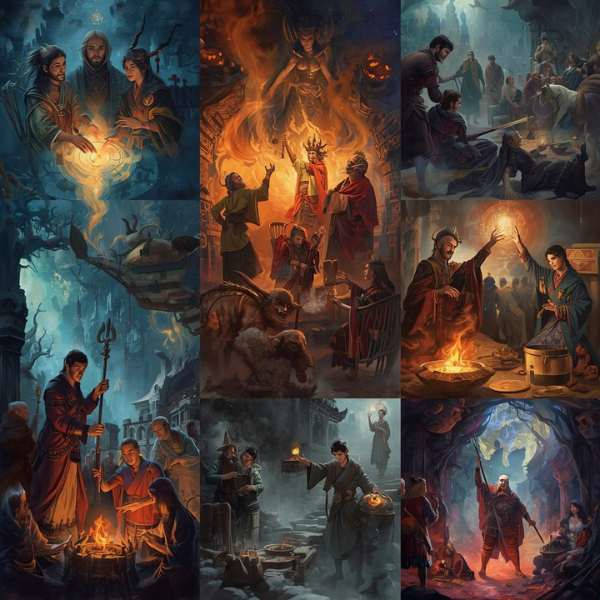
When we think of Halloween, we imagine pumpkins glowing in the dark, children dressed as witches, and bowls overflowing with candy. But behind this fun and colorful celebration lies a much older — and more mysterious — world of superstitions, rituals, and forgotten symbols.
Long before Halloween became a night for costumes and sweets, it was a sacred and superstitious time when people across Europe and Asia performed rituals to protect themselves from spirits, attract good fortune, and even foresee their future. These beliefs, passed down through centuries, form what we could call “the other Halloween” — a night not of entertainment, but of connection with the invisible world.
From Scottish divinations to Slavic fire rites and Asian protective customs, these strange traditions reveal how humanity has always tried to understand — and control — the unseen. Let’s travel through time and across cultures to uncover the superstitions that still haunt the world every October 31st. 🌙
🎃 1. The Celtic World: Where Halloween Was Born
Halloween’s oldest roots lie in ancient Celtic lands — modern-day Ireland, Scotland, and Wales — where people celebrated Samhain, the festival that marked the end of summer and the start of winter.
The Celts believed that on the night of October 31st, the boundary between the living and the dead faded, allowing spirits to cross over. To survive the night safely, people relied on rituals, charms, and symbolic actions — many of which survive today, often in playful or disguised forms.
🔥 Fire and Protection
Fire was central to Samhain. Bonfires were lit on hilltops to ward off evil spirits and honor protective deities. People carried embers from sacred fires back home to relight their hearths, symbolizing purification and renewal.
In Scotland and Ireland, turnip lanterns — the ancestors of modern pumpkins — were carved to frighten away wandering souls. The grotesque faces represented the spirits themselves or the mythic figure of Stingy Jack, who roamed the earth with a lantern after tricking the Devil.
🔥 Superstition: It was believed that if your fire went out during Samhain night, death or misfortune would strike your household before the year ended.
Mirror Magic and Future Lovers
For unmarried women, Halloween was a night of romantic fortune-telling. In Scotland and Ireland, young women gazed into mirrors by candlelight while eating an apple or brushing their hair, hoping to see the face of their future husband appear behind them.
🍎 Superstition: Peel an apple in one long strip and throw it over your shoulder — the peel would land in the shape of your future lover’s initial.
Though these games may sound like fun, they were deeply symbolic: Halloween was considered a “liminal night”, when humans could glimpse not only the dead, but also their destinies.
🧙♀️ 2. The Witches’ Night: Scottish and Welsh Beliefs
In Scotland and Wales, Halloween (or Nos Calan Gaeaf in Welsh) was also known as the night of witches and spirits. People believed that supernatural forces roamed freely, seeking souls to take or blessings to give.
🐈 The Cat and the Cauldron
The image of the black cat — today a cute Halloween cliché — was once a symbol of magic and transformation. In Celtic and Scottish folklore, the Cat Sìth, a fairy creature resembling a large black cat with a white spot on its chest, was said to steal the souls of the dead before the gods could claim them.
To keep the Cat Sìth away, families left dishes of milk outside their homes — a simple act of respect that could mean the difference between protection and doom.
🐾 Superstition: A black cat crossing your path could bring either good or bad luck, depending on your relationship with the spirit world. For witches, it was a blessing; for others, a warning.
🧙 The Cauldron: Symbol of Rebirth
In Welsh mythology, the cauldron represented life, death, and rebirth — a sacred vessel belonging to the goddess Ceridwen. During Halloween, it symbolized the womb of the earth, from which souls were reborn.
Many villagers placed bowls of food or milk outside their doors as offerings to wandering spirits — the ancient origin of today’s trick-or-treating.
🧛♂️ 3. The Slavic Night of Fire and Shadows
Far to the east, Slavic peoples celebrated similar autumn festivals that honored the dead and sought protection from evil. Known as Dziady in Poland and Belarus or Radunitsa in Russia, these nights blurred the line between life and afterlife — just like Samhain.
🕯️ The Fire of the Ancestors
In Eastern Europe, families gathered around bonfires in cemeteries, lighting candles and sharing food with their deceased relatives.
It was believed that spirits could warm themselves by the flames, so keeping the fire alive meant showing respect and ensuring family protection.
🔥 Superstition: If the fire went out suddenly, it was a sign that a wandering ghost had taken offense — bad luck for the entire household.
👻 The Window to the Afterlife
Windows played a key role in Slavic superstition. On Halloween-like nights, villagers opened windows slightly to let souls enter or leave peacefully. Closing them too tightly was seen as an act of disrespect.
💨 Superstition: A sudden cold wind passing through an open window was believed to be the touch of a spirit, either blessing or warning the living.
Even today, lighting candles in windows during All Saints’ and All Souls’ Days across Eastern Europe reflects this ancient communion between the living and the dead.
🕉️ 4. Asian Traditions: Ghosts, Spirits, and the Hungry Dead
Though Halloween originated in the Celtic world, Asia has its own “nights of spirits”, where people try to maintain harmony with the dead through rituals and offerings. These customs are remarkably similar in meaning, even if they developed independently.
China: The Hungry Ghost Festival
In Chinese tradition, the seventh month of the lunar calendar is the Ghost Month, when the gates of the afterlife open and spirits return to earth. The Ghost Festival — sometimes called the “Chinese Halloween” — is celebrated with candles, incense, and food offerings.
🔥 Superstition: Never whistle at night during Ghost Month — it’s believed to attract wandering ghosts.
To avoid angering these spirits, people burn joss paper — symbolic money or items — to provide comfort in the afterlife. The parallels with Samhain are striking: both reflect a respectful fear of the dead, balanced by ritual generosity.
Japan: Obon
In Japan, the Obon Festival, celebrated in August, honors ancestors through lanterns, dances, and prayers. Families light floating lanterns to guide spirits home — just as Celts once used bonfires and marigolds for the same purpose.
💡 Superstition: During Obon, mirrors are often covered to prevent spirits from getting trapped inside — a belief shared by Western folklore, where mirrors were also thought to capture souls.
5. Forgotten Symbols: Mirrors, Cats, and Fire 🔮
Many of the objects we associate with Halloween today — from black cats to flickering candles — have deep symbolic meanings that go far beyond decoration.
Let’s look closer at the forgotten stories behind these ancient symbols.
🪞 Mirrors: Portals Between Worlds
Since antiquity, mirrors have been seen as gateways to the supernatural. During Halloween and similar festivals, many cultures believed that looking into a mirror by candlelight could reveal spirits, omens, or even the face of your future love.
But mirrors also carried danger. Breaking one was said to bring seven years of bad luck, echoing the belief that a shattered reflection damaged your soul’s image.
🧿 Superstition: Cover mirrors when someone dies — otherwise, their spirit may become trapped inside.
🐈 Cats: Guardians of the Spirit World
The association between cats and witchcraft goes back to ancient Egypt, where cats were sacred to Bastet, the goddess of protection. In medieval Europe, black cats were unfairly demonized, believed to be witches’ familiars or even witches in disguise.
Yet in Celtic and Scottish folklore, cats were not evil — they were guardians between worlds, protecting homes from curses.
🐈 Superstition: Treat a black cat kindly, and it will bring prosperity; mistreat it, and you invite misfortune.
🔥 Fire: The Eternal Protector
Across nearly every culture, fire represents life, purity, and protection from darkness. During Halloween, Samhain, or Dziady, fire was more than light — it was a symbolic barrier against chaos.
The practice of lighting candles inside pumpkins or lanterns comes from this ancient faith in fire’s power to repel evil. Even today, the flickering candle remains one of Halloween’s most enduring and sacred symbols.
🕯️ 6. Superstitions That Survive Today
Though most people now celebrate Halloween for fun, many ancient superstitions persist — sometimes unconsciously:
- Knocking on wood for good luck 🌳
- Crossing fingers to wish for something 🤞
- Avoiding walking under ladders 🚫
- Saying “Bless you” when someone sneezes 😷 (to protect their soul from escaping)
- Avoiding broken mirrors or spilled salt ⚖️
Each of these modern habits has pagan or spiritual roots, reminders that even in our rational age, the old magic still lives within our daily gestures.
🌙 7. Why These Superstitions Endure
From an anthropological point of view, these ancient beliefs survive because they answer deep human needs — to feel safe, to find meaning in uncertainty, and to stay connected with the unseen.
Fear of death, desire for luck, and respect for mystery are universal emotions, transcending religion or geography. Halloween and its hidden superstitions remind us that the rational and the magical have always walked side by side.
As cultural anthropologist Mary Douglas once said, “Ritual is how humans domesticate danger.” Halloween, in this sense, is not just a party — it’s a ritual of controlled fear, a night when we turn our anxieties into stories, games, and symbols.
🌌 8. Conclusion: The Eternal Night Between Worlds
Behind every pumpkin and every ghost costume lies a thousand-year-old conversation between the living and the dead.
From the fires of ancient Ireland to the lanterns of Japan, from the Cat Sìth to the Hungry Ghost, every superstition tells the same story: that humanity has always sensed something beyond the visible world.
So, next time you light a candle, knock on wood, or see a black cat cross your path — pause for a moment. You may be participating in the other Halloween — the ancient, mysterious one that still whispers beneath the modern celebration.
✨ After all, superstition is not ignorance — it’s memory. A living echo of the world our ancestors feared, respected, and loved.
📚 Sources
- National Museum of Ireland – Samhain and Irish Folklore
- BBC History – Halloween’s Ancient Origins
- Smithsonian Magazine – Fire Festivals and Celtic Rituals
- The British Museum – Superstitions and Symbols in Early Europe
- Encyclopedia of Anthropology – Rituals of Death and Protection in Slavic and Asian Cultures
- Japan National Tourism Organization – Obon: The Festival of Spirits
- China Highlights – The Hungry Ghost Festival Explained

